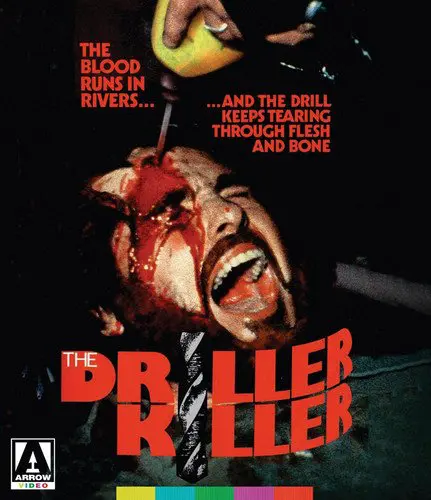
The Driller Killer is known mostly for being Abel Ferrara’s directorial debut (if one discounts 9 Lives of a Wet Pussy, the hard-core porno he helmed three years prior) and for being one of first films put on England’s notorious Video Nasties list.
I first came across it in a bootleg DVD shop in Shanghai. It was one of the few places I’d found in that city that carried art-house, classics, and other oddball films. The title alone had me curious and that scandalous cover featuring a blood-soaked face being punctured by an electric drill made me want to watch it stat, but I knew my wife would give me grief over buying it. So it sat on the shelf and I stood staring at it every time we came in.
It’s stayed in my mind all these years later. Many times I’ve wondered what gore-filled delights awaited me inside the film. What other skulls would be so delightfully drilled into? When Arrow Video announced it was releasing a special edition of the film on Blu-ray, I knew my time had come.
Alas, some things are best left to the imagination. The Driller Killer plays like a Taxi Driver knock-off whose arthouse ambitions are overcome by its need to fill grindhouse seats. It’s a low-budget horror flick that clearly wants to say something of import but keeps getting distracted by slow-motion nudity and buckets of blood.
Ferrara, under the pseudonym Jimmy Laine, plays Reno, a down-on-his-luck artist who might make something of himself if he could just catch a break. He lives in a run-down apartment in the Union Square district of Manhattan (it was filmed in Ferrara’s own apartment at the time) with Carol (Carolyn Marz), his sort-of girlfriend, and ditzy groupie Pamela (Baybi Day). He is poor and impotent. His indifferent landlord (Alan Wynroth) threatens to evict him, his telephone is about to get cut off, and Dalton (Harry Schultz II), the art-gallery owner who supports Reno, is refusing to loan him anymore money until his next painting is finished. Then a punk band moves in downstairs playing loud music all hours of the day and night. And lately, Carol seems more interested in taking gratuitously long showers with Pamela rather than spend time with him.
It all proves to much for Reno and after he sees an ad for a portable electric belt that you can plug anything you like into and take it on the go, he gets himself one, plus a big electric drill, and releases himself with a little ultra-violence. As if screwing holes into people with a giant drill wasn’t phallic enough, Reno writhes on top of one of his earliest victims while blood squirts out of him in orgiastic glee.
It is not a subtle film. Nor a particularly good one. Its pacing is too slow and the gore comes in too late to please horror-hounds, and its too over-the-top in its violence to endear it to the arthouse crowd. There is a touch of something, a hint of artistry and craftsmanship that demonstrate a glimmer of Ferrara’s talent, but ultimately, I can only recommend it to die-hard fans of his or those who simply must see all the video nasties.
Arrow has once again done a remarkable job in its presentation. The video looks as good as a low-budget horror film on cheap 16mm stock could. They’ve cleaned it up from debris and damage though it still maintains plenty of grain and low-fi fuzz. The sound, likewise, is about as good as one expects. There are lots of long scenes of the punk band performing and they come in loud and clear. The dialogue was always audible.
When they were restoring the film from its original negatives, they realized they had about five minutes of extra footage that had been cut before the final release of The Driller Killer. It amounts to nothing much, just small moments cut out at the last minute from multiple scenes, but this is the first time its been released anywhere. There is a new commentary by Abel Ferrara (moderated by writer Brad Stevens) plus a new interview with the director. Also included is a really nice retrospective visual essay on the director by Alexandria Heller-Nicholas and Mulberry St., a documentary shot by Ferrara about his love of New York City and the various locations he’s used for his films.
He’s poor, impotent, and finding it difficult to finish his painting. Then a punk band moves in downstairs playing loud music all hours of the day and night.